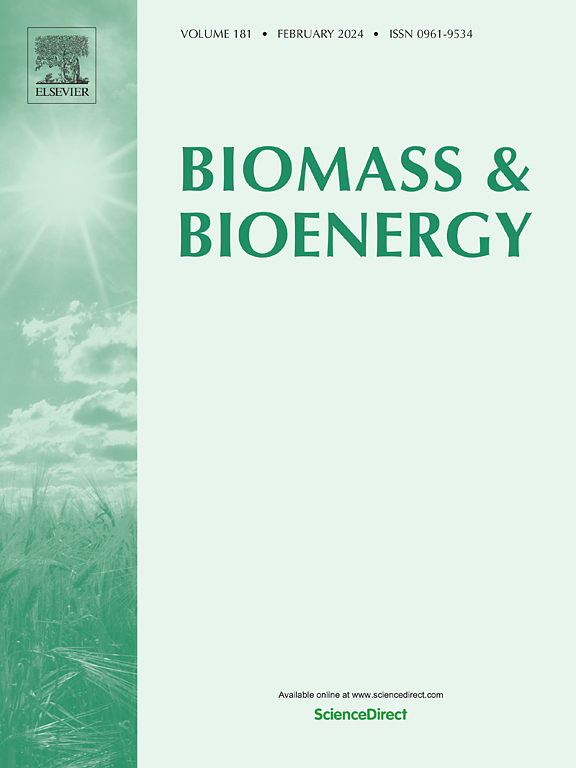Production of 5-hydroxymethylfurfural and 2,5-dimethylfuran from fructose using wine lees-derived C-SO3H and Pt5Fe5/C catalyst
IF 5.8
2区 生物学
Q1 AGRICULTURAL ENGINEERING
引用次数: 0
Abstract
Direct production of 2,5-dimethylfuran (DMF) from fructose is crucial for developing biomass-derived fuels, yet it presents significant challenges due to the need for multifunctional active sites for dehydration and hydrodeoxygenation. Meanwhile, the disposal of wine lees, a major winemaking by-product, incurs substantial costs. Herein, a hybrid catalyst system of sulfonated wine lees carbon (WLC-SO3H) and PtFe/C was introduced, achieving a DMF yield of 66.4 % directly from fructose. WLC-SO3H, with enhanced Brønsted acidity, demonstrated high activity in dehydrating fructose to 5-hydroxymethylfurfural (HMF) with a 98.2 % yield. PtFe/C effectively catalyzed the hydrodeoxygenation of HMF to DMF, driven by the strong interaction between Pt and Fe species. This interaction was confirmed through in situ DRIFTS and theoretical calculations, highlighting the system's superior catalytic performance.

使用源自酒糟的 C-SO3H 和 Pt5Fe5/C 催化剂从果糖生产 5-羟甲基糠醛和 2,5-二甲基呋喃
从果糖直接生产 2,5-二甲基呋喃(DMF)对开发生物质衍生燃料至关重要,但由于脱水和加氢脱氧需要多功能活性位点,这给生产带来了巨大挑战。同时,酒糟作为一种主要的酿酒副产品,其处理也需要大量成本。在此,我们引入了一种由磺化酒糟碳(WLC-SO3H)和铂铪/铂碳组成的混合催化剂体系,直接从果糖中获得了 66.4% 的 DMF 收率。WLC-SO3H 具有增强的布氏酸性,在将果糖脱水为 5- 羟甲基糠醛 (HMF) 的过程中表现出很高的活性,产率达 98.2%。由于铂和铁之间的强相互作用,PtFe/C 能有效地催化 HMF 的加氢脱氧生成 DMF。这种相互作用通过原位 DRIFTS 和理论计算得到了证实,凸显了该体系的卓越催化性能。
本文章由计算机程序翻译,如有差异,请以英文原文为准。
求助全文
约1分钟内获得全文
求助全文
来源期刊

Biomass & Bioenergy
工程技术-能源与燃料
CiteScore
11.50
自引率
3.30%
发文量
258
审稿时长
60 days
期刊介绍:
Biomass & Bioenergy is an international journal publishing original research papers and short communications, review articles and case studies on biological resources, chemical and biological processes, and biomass products for new renewable sources of energy and materials.
The scope of the journal extends to the environmental, management and economic aspects of biomass and bioenergy.
Key areas covered by the journal:
• Biomass: sources, energy crop production processes, genetic improvements, composition. Please note that research on these biomass subjects must be linked directly to bioenergy generation.
• Biological Residues: residues/rests from agricultural production, forestry and plantations (palm, sugar etc), processing industries, and municipal sources (MSW). Papers on the use of biomass residues through innovative processes/technological novelty and/or consideration of feedstock/system sustainability (or unsustainability) are welcomed. However waste treatment processes and pollution control or mitigation which are only tangentially related to bioenergy are not in the scope of the journal, as they are more suited to publications in the environmental arena. Papers that describe conventional waste streams (ie well described in existing literature) that do not empirically address ''new'' added value from the process are not suitable for submission to the journal.
• Bioenergy Processes: fermentations, thermochemical conversions, liquid and gaseous fuels, and petrochemical substitutes
• Bioenergy Utilization: direct combustion, gasification, electricity production, chemical processes, and by-product remediation
• Biomass and the Environment: carbon cycle, the net energy efficiency of bioenergy systems, assessment of sustainability, and biodiversity issues.
 求助内容:
求助内容: 应助结果提醒方式:
应助结果提醒方式:


